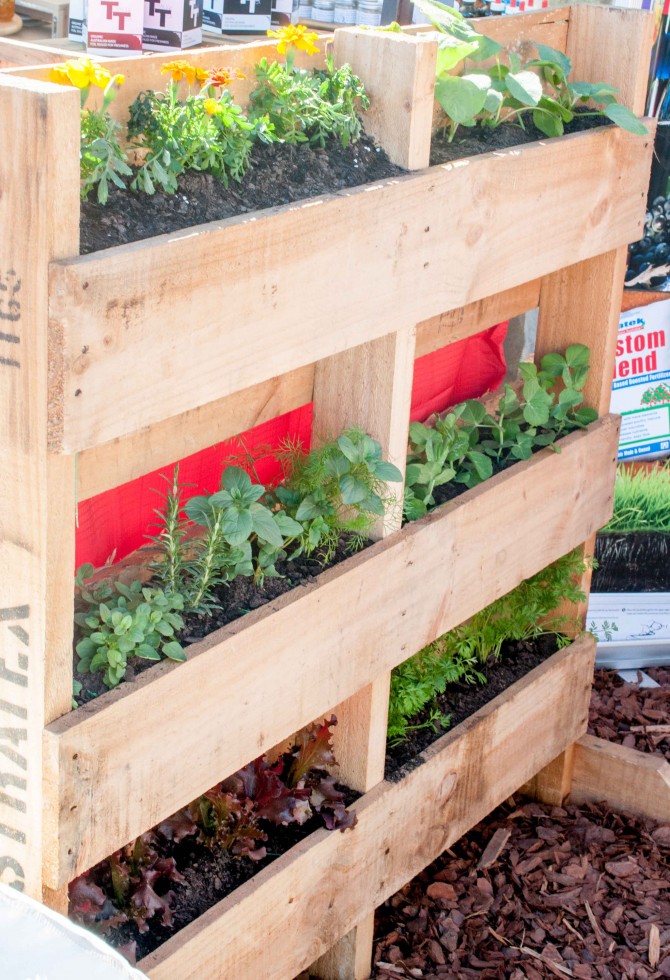Upcycling is a fantastic way to reduce waste and create something beautiful for your home and garden. One of the most versatile materials for upcycling is the humble wooden pallet. Transforming a pallet into a vertical flower garden is a rewarding project that adds a touch of rustic charm to any space. This guide will walk you through the process, providing you with the knowledge and inspiration to create your own stunning pallet garden.
Choosing the Right Pallet and Preparing It
Not all pallets are created equal. Selecting the right one and preparing it properly is crucial for a successful flower garden.
Selecting a Safe Pallet
Before you start, make sure the pallet is safe to use for gardening. Look for the following:
- Heat Treatment (HT): Pallets marked with “HT” have been heat-treated and are safe.
- Avoid MB: Do NOT use pallets marked with “MB” (methyl bromide), as this is a toxic fumigant.
- Cleanliness: Choose a pallet that is clean and free from any visible stains or spills.
Preparing the Pallet
Once you have a safe pallet, follow these steps to prepare it:
- Cleaning: Thoroughly clean the pallet with soap and water. A pressure washer can be helpful.
- Sanding: Sand down any rough edges or splinters to prevent injury.
- Repairing: Repair any broken boards or loose nails. Use wood glue and screws for added stability.
- Sealing (Optional): Apply a sealant or wood preservative to protect the pallet from the elements and extend its lifespan. Ensure the sealant is plant-safe.
Creating the Planting Pockets
Now comes the fun part: creating the pockets where your flowers will grow.
Lining the Pockets
To prevent soil from falling out, you’ll need to line the pockets.
- Landscape Fabric: Cut landscape fabric to fit the inside of each pocket, leaving enough overlap to secure it.
- Stapling: Staple the fabric securely to the inside of the pallet, creating a pouch.
- Alternative Liners: You can also use burlap, thick plastic sheeting, or even old coffee sacks.
Adding Soil
Choose a good quality potting mix that drains well.
- Filling: Carefully fill each lined pocket with potting mix.
- Compacting: Gently compact the soil to create a firm base for your plants.
- Watering: Water the soil thoroughly to help it settle.
Factoid: Pallet gardens are excellent for small spaces, such as balconies or patios. They allow you to grow a variety of plants vertically, maximizing your gardening potential.
Planting Your Flowers
Select flowers that are suitable for the amount of sunlight your pallet garden will receive.
Choosing the Right Plants
Consider these factors when choosing your plants:
- Sunlight: Choose plants that thrive in the amount of sunlight your garden receives (full sun, partial shade, or full shade).
- Size: Select plants that won’t outgrow the pockets too quickly.
- Water Needs: Choose plants with similar water requirements.
- Color and Texture: Mix and match different colors and textures to create a visually appealing garden.
Planting Techniques
Gently remove the plants from their containers and loosen the roots before planting.
- Planting: Carefully plant each flower in its designated pocket.
- Spacing: Allow enough space between plants for them to grow.
- Watering: Water the newly planted flowers thoroughly.
Maintaining Your Pallet Garden
Regular maintenance is essential to keep your pallet garden looking its best.
Watering
Water your plants regularly, especially during hot weather. Check the soil moisture by sticking your finger into the soil. If it feels dry, it’s time to water.
Fertilizing
Feed your plants with a balanced liquid fertilizer every few weeks to promote healthy growth and flowering.
Pruning
Prune your plants regularly to remove dead or dying leaves and flowers. This will encourage new growth and keep your garden looking tidy.
Pest Control
Inspect your plants regularly for pests and diseases. Treat any problems promptly with organic pest control methods.
FAQ: Pallet Garden Edition
Are all pallets safe to use for gardening?
No. Only use pallets marked with “HT” (heat treated). Avoid pallets marked with “MB” (methyl bromide), as they are treated with a toxic fumigant.
What kind of soil should I use?
Use a good quality potting mix that drains well;
How often should I water my pallet garden?
Water regularly, especially during hot weather. Check the soil moisture and water when it feels dry.
What plants are best for a pallet garden?
Choose plants that are suitable for the amount of sunlight your garden receives and that won’t outgrow the pockets too quickly. Good choices include herbs, strawberries, succulents, and annual flowers like petunias and impatiens.
How do I protect my pallet garden from the weather?
Apply a sealant or wood preservative to protect the pallet from the elements. Consider moving the garden to a sheltered location during extreme weather conditions.

